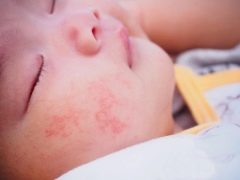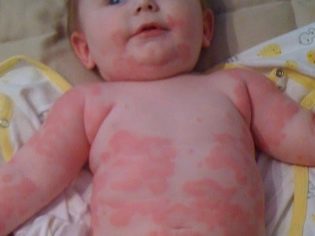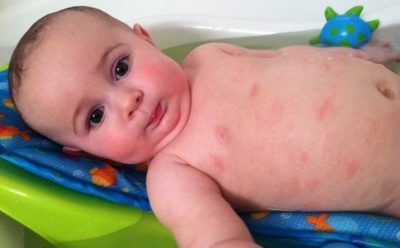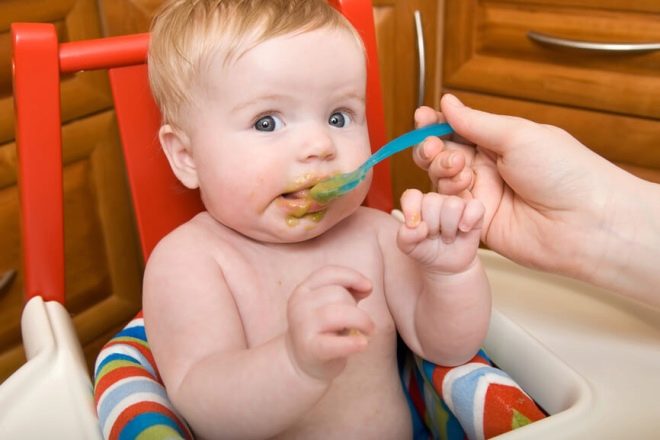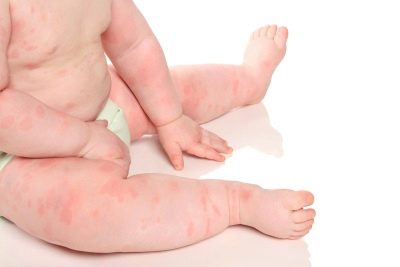Urticaria in infants: from symptoms to treatment
Urticaria in infants is a fairly common and unpleasant phenomenon. It is in infancy that such a dermatological problem occurs most often. According to statistics, up to 15% of children under two years of age suffer from urticaria in varying degrees.
What it is?
Externally, the rash resembles burns from contact with nettles. Hence the name of this dermatological problem. Rashes appear quickly, spread rapidly, are accompanied by itching.
Usually, this form of dermatitis develops as an organism’s response to contact with an allergen. If this contact is permanent, the urticaria goes into the category of chronic ailments.
The attitude to the hives in the people is not too serious, and this is the main mistake of the parents. In almost half of the cases, the appearance of "nettle" rash occurs simultaneously with angioedema, but more often it precedes it. Laryngeal edema can be fatal.
The body of an infant is not protected by immunity to the extent that the organisms of adults and older children are protected. And therefore it is impossible to predict the appearance of urticaria - no one knows how a baby’s immunity will accept one or another antigen.
Varieties
- Have a newborn and an infant urticaria rash most often acute. Only in some cases, if mom and dad can not establish the cause, the urticaria becomes chronic.
- Most common allergic urticaria, the cause of which is the inadequate reaction of children's immunity to a certain allergen (in food, contact, in the environment, etc.).
- Sometimes found pseudogradnitsin which characteristic rashes appear as a skin response to a mechanical touch. This form is called dermatographic dermatosis.
- Also release urticaria caused by pressure, cold, vibration, contact, akvagennuyu. Traditionally, it is common to refer to urticaria and mastocytosis, and psychogenic urticaria.
Any form of dermatosis is not contagious and not dangerous for people around the child.
Causes and symptoms
Nettle rash on the skin of an infant - a consequence of the thinning of the capillaries under the action of release of histamine into the blood. When in contact with an allergen, the concentration of histamine increases, the walls of blood vessels become fragile, the intracellular fluid begins to pour into the epidermis. And characteristic rashes are formed.
In infancy, food allergies become the most common cause of hives. - so the child can react to complementary foods, new food products in the diet. Sometimes urticaria develops as a form of contact allergy. - Infants' skin is very thin and tender, and even the wrong powder for washing baby clothes can cause a rash.
The urticaria skin of the baby can react to vaccination, more precisely, to the components of vaccines, insect bites, friction diaper or the seams of clothing.
Parents should be prepared for the fact that, in about a third of cases, the true cause cannot be identified.
Hives are difficult to confuse with something else, because unlike other allergies, diaper rash, prickly heat, it appears quickly, in just a few minutes. Blisters are pink, numerous. They are almost never isolated.. If the baby has isolated individual blisters, then an infection should be suspected, and not a rash.
Urticaria not only quickly appears and looks like a burn from the plant of the same name, but also passes quickly. As the concentration of histamine in the blood begins to decrease, the rash also disappears.. Neither diaper rash nor infection pass so quickly. This is the main symptom of pathology.
Rash with nettle fever (this is the second name for urticarial dermatosis) itching, itching. There is a slight swelling around the blisters. If the rash appears solely on the face or hands, then the general condition does not suffer. If the rash is extensive, the rise in body temperature is not excluded.
An infant with extensive widespread urticaria is having difficulty falling asleep, is naughty, has an appetite, and has a stool. TORapiva in infants is often referred to as strophulus. With it, the blisters are small, not exceeding 3 millimeters., with a small bubble on top.
With the development of giant urticaria, laryngeal edema (angioedema) and other forms of edema are formed. In this case, the child has difficulty breathing, he needs urgent medical care. Before the arrival of the "ambulance" parents should provide the child with fresh air.
Toxic urticaria from contact with chemicals or strong allergens develops quickly, the rash spreads rapidly.
How to treat?
Often parents have the impression that since the urticaria quickly appears and quickly disappears, there is no need to treat it. In fact, it is important to decide what is considered treatment. If the infant has urtikarny dermatosis, it is a signal to the parents. They must reconsider the conditions of life, nutrition crumbs. And these measures are also a treatment.
First of all it is important to eliminate the allergen. But since it is not always possible to detect it, the actions should be large-scale.
All household chemicals should be isolated and closed in a separate room, mom will have to wash floors more often and without the addition of detergents, especially on the basis of chlorine. Wash baby and bed linen should only hypoallergenic baby powderswhich are specially created for the smallest and their sensitive skin. It is important to remember what new foods the nursing mother introduced into her diet or as a complementary food to the baby. It is possible that the reaction has developed on them. But the product search area will be small - the hives develop quickly, and therefore it suffices to recall that the child ate a few hours ago.
For treatment use antihistamine drugs, for example, "Suprastin", "Diazolin" - the pediatrician will more specifically say. The need for them is mainly only in children who have urticaria occurs quite often. Topical anti-pruritic ointment, cooling and soothing discomfort in the area of rash can be recommended topically.
When a food reaction is detected, it is additionally recommended to give the child enterosorbents (Enterosgel) in order to quickly remove the antigen that caused the allergy from the child’s body.
Often parents are interested in whether it is possible to wet the hives and bathe the child with her. There are no prohibitions on water procedures, as well as on walks.
Prohibited actions
Parents of babies who are faced with urticaria are usually at a loss. In this case, we have compiled a memo that should not be done in any way:
- you can not burn the rash alcohol solutions, as well as aniline dyes (green paint, strong, etc.) - this is not necessary;
- You should not give the child any medicines before being examined by a doctor, especially antibiotics, painkillers, sleeping pills;
- You can not use any means of traditional medicine, because the vegetable components of non-traditional recipes can only aggravate the situation.
Tips of Dr. Komarovsky
In order not to treat the urticaria in infants, pediatrician Yevgeny Komarovsky recommends doing everything so as not to create prerequisites for it.First of all, it is important to remember that nutrition of a nursing mother should be correct, diverse, balanced, but devoid of foods with a high allergenicity index. Also, introducing complementary foods in 6 months and older, It is important to add no more than one new product to a peanut diet in 2 days in order to have time to evaluate the reaction of the child’s body. Otherwise it will be quite difficult to establish what exactly the child had a rash.
Komarovsky does not advise limiting the communication of a child of the first year of life with pets - in contact with certain antigens, a child is much less likely to become allergic than a baby, which parents try to keep in sterile conditions.
The apartment needs to get rid of everything that can accumulate house dust. - large soft toys, soft carpets and carpets, books, if they are not stored in the closet behind the glass, it is better to temporarily remove away.
More attention should be paid to wet cleaning. For additional moistening of the air, it is possible to install an aquarium with fish in the child’s room - both useful and pleasant.
Linen baby Komarovsky advises to rinse after washing in water that is devoid of chlorine, that is, pre-boiled. Also should pay special attention to clothing. It should be sewn of natural fabrics. You can not put a child up - with increased sweating, the likelihood of dermatosis, including urticaria, increases several times.
The doctor recommends giving any medications only if there is a need for them, that is, the disease is diagnosed and the medicine itself is prescribed by a pediatrician. There is no safe medicine.
How to avoid?
There is no allergy vaccination, there are no urticaria vaccines in the world, and therefore, the prevention of dermatoses in infancy is nonspecific. Much depends on how parents relate to the world and the dangers that it contains. It has been proven that children who are protected from everything and who are not allowed on the street to pet the cat or smell the flower in the flowerbed are more likely to suffer from various allergic manifestations. Hardening, walks are useful for children's immunity. Do not overfeed baby.
All hazardous substances that may cause urticaria should be kept away so that the child cannot reach them. If the urticaria has already developed at least once, it is important to warn your pediatrician about this., and before each vaccination to be given to the child, just in case, give him a dose of an antihistamine, in order to eliminate the likelihood of recurrence of urticarial dermatosis.
